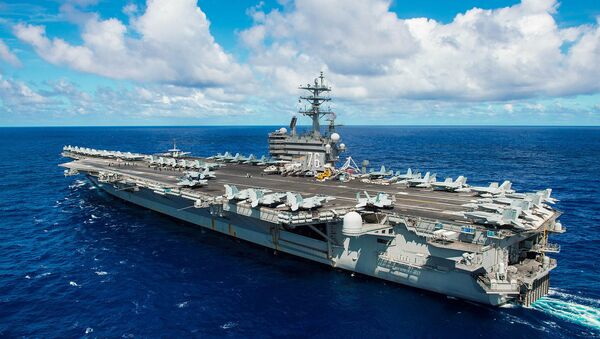The operations included air defense drills, sea surveillance, replenishments at sea, long-range strikes and more. About 12,000 sailors, 140 aircraft and six warships are involved in the operation.
“Today, we continue that long history as our two carrier strike groups maneuver together in the Philippine Sea,” Rear Adm. Marcus Hitchcock, commander of CSG 3/Stennis CSG, said in the Navy news release.
“No other Navy can concentrate this much combat power on one sea or synchronize the activities of over 12,000 sailors, 140 aircraft, six combatants and two carriers. It was truly impressive, and it is an important operational capability.”
According to the Pentagon, these maneuvers are not a response to any crisis, whereas the concentration of so many personnel is included in the program of combat training.
However, according to the experts this is “nothing more than another signal to China.”
China claims nearly all of the South China Sea as its sovereign territory and has reinforced its claims by constructing man-made islands on rocky outcroppings and reefs in the region. The US has opposed what it sees as China's forced tactics to enforce its claims.
This joint US and Philippine patrols in the South China Sea with the participation of the Stennis aircraft carrier was strictly regarded by Beijing as “the embodiment of the mentality of the Cold War” and the militarization of the region.
The lawsuit was filed by the Philippines as Manila voiced protest against Chinese claims to an exclusive economic zone (EEZ) around a series of reefs, rocks and other formations in the archipelago of the Spratly (Nansha) and some other areas in the South China Sea.
In the case of the court's decision not in favor of China, the United States and its allies in the region will demand of China to recognize and execute a legal decision formally binding the parties to the UN Convention on the Law of the Sea. The United States itself has not yet ratified this international legal document.
Until now, all the US’ attempts to put pressure on Beijing and make it stop its claims on the region had no special effect. China has not shown any signs of weakness nor intent to compromise on those terms, which it considers to be fundamental.
As far as Russia is concerned, it has a non-interference position. According to Russian expert and orientalist, Ilya Usov, it is in the interests of Russia to develop diversified relations with all countries of the Asia-Pacific, while maintaining a privileged partnership with China.
“The situation has changed due to the increasing role of China in the region. As a strong player with a fairly active offensive position, it scares the neighbors, with whom, historically it had difficult relations. But! These countries are promising partners for Russia in its pivot to the East, as was demonstrated during the recent ASEAN-Russia summit in Sochi,” Usov said.
He further added that Russia therefore, does not intend to abandon its neutrality and even purely out of geographical reasons it cannot be a part of the dispute.
“We have always insisted that the parties of the dispute must resolve the situation through peaceful dialogue. Russia is not going to retreat from that position,” the analyst concluded.




